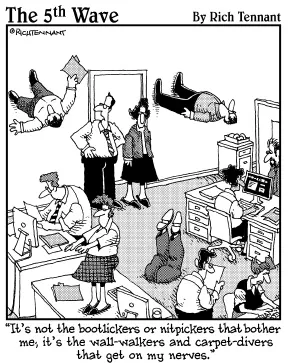Part I
Getting Started as a Manager
In this part . . .
Before you can become an effective manager, you need to master some basic skills. In this part, you find out what you’re expected to do as a manager and the challenges you may face. Then we cover some of the most important managing skills that will take you far in your position, including becoming a leader, inspiring employees through support and rewards, and creating an engaged workforce through communication and autonomy.
Chapter 1
You’re a Manager — Now What?
In This Chapter
Figuring out what the heck management is
Moving from being a doer to being a manager of doers
Understanding the changing workforce
Defining the key functions of management
Taking the first steps toward becoming a manager
Managing is truly a calling — one that, during our long tenures as managers, we authors are proud to have answered. We’re the few. The proud. The managers. In the world of business, no other place allows you to have such a direct, dramatic, and positive impact on the lives of others and on the ultimate success of your enterprise. This chapter provides an overview of the challenging and ever-changing world of management. Whether you’re a manager or a manager-to-be, you can benefit from our inside look into the kinds of management techniques that can help you get the best from your employees every day of the week.
Identifying the Different Styles of Management
One definition describes management as “getting things done through others.” Another definition more specifically defines management as “making something planned happen within a specific area through the use of available resources.” Seems simple enough. So why do so many bright, industrious people have trouble managing well? And why do so many companies today seem to offer a flavor-of-the-month training program that changes each time some new management fad blows through the business scene?
Unfortunately, good management is a scarce commodity, both precious and fleeting. Despite years of changing management theory and countless management fads, many workers — and managers, for that matter — have developed a distorted view of management and its practice. Managers often don’t know the right approach to take or exactly what to do. And as the saying goes, “If it’s foggy in the pulpit, it’ll be cloudy in the pew.” Do you ever hear any of the following remarks at your office or place of business?
“We don’t have the authority to make that decision.”
“She’s in charge of the department — fixing the problem is her responsibility, not ours.”
“Why do they keep asking us what we think when they never use anything we say?”
“I’m sorry, but that’s our policy. We’re not allowed to make exceptions.”
“If my manager doesn’t care, I don’t, either.”
“It doesn’t matter how hard you work; no one’s going to notice anyway.”
“You can’t trust those employees — they just want to goof off.”
When you hear remarks like these at work, red lights should be flashing before your eyes, and alarm bells should be ringing loudly in your ears. Remarks like these indicate that managers and employees aren’t communicating effectively — that managers don’t trust their employees, and that employees lack confidence in their managers. If you’re lucky, you find out about these kinds of problems while you still have a chance to do something about them. If you’re not so lucky and you miss the clues, you may be stuck repeatedly making the same mistakes. The expectations and commitments that employees carry with them on the job are largely a product of the way their managers treat them. Following are the most commonly adopted styles of management. Do you recognize your management style?
Tough guy (or gal) management
What’s the best way to make something planned happen? Everyone seems to have a different answer to this question. Some people see management as something you do to people — not with them. Does this type of manager sound familiar? “We’re going to do it my way. Understand?” Or perhaps the ever-popular threat: “It had better be on my desk by the end of the day — or else!” If worse comes to worst, a manager can unveil the ultimate weapon: “Mess up one more time, and you’re out of here!” This type of management is often known as Theory X management, which assumes that people are inherently lazy and need to be driven to perform. Managing by fear and intimidation is always guaranteed to get a response. The question is, do you get the kind of response you really want? When you closely monitor your employees’ work, you usually end up with only short-term compliance. In other words, you never get the best from others by lighting a fire under them — you have to find a way to build a fire within them.
Sometimes managers have to take command of the situation. If a proposal has to be shipped out in an hour and your customer just sent you some important changes, take charge of the situation to ensure that the right people are on the task. When you have to act quickly with perhaps not as much discussion as you’d like, however, it’s important to apologize in advance and let people know why you’re acting the way you are. Remember that the majority of employees leave their positions because of the actions (or lack thereof) of their direct supervisor or manager. So make sure you move quickly but with clear communication and respect for your staff.
Nice guy (or gal) management
At the other end of the spectrum, some people see management as a “nice guy” or “nice gal” kind of idea. Theory Y management assumes that people basically want to do a good job. In the extreme interpretation of this theory, managers are supposed to be sensitive to their employees’ feelings and avoid disturbing their employees’ tranquility and sense of self-worth. This approach may come across like this: “Uh, there’s this little problem with your report; none of the numbers are correct. Now, don’t take this personally, but we need to consider our alternatives for taking a more careful look at these figures in the future.” This scenario also plays out when someone from the peer group is promoted into a management position. He sometimes can’t easily transition from being a buddy into being the manager.
Again, managers may get a response with this approach (or they may choose to do the work themselves!), but are they likely to get the best possible response? No, the employees are likely to take advantage of the managers.
The right kind of management
Good managers realize that they don’t have to be tough all the time — and that nice guys and gals often finish first. If your employees are diligently performing their assigned tasks and no business emergency requires your immediate intervention, you can step back and let them do their jobs. Not only do your employees learn to be responsible, but you also can concentrate your efforts on what is most important to the bottom-line success of your organization.
A manager’s real job is to inspire employees to do their best and establish a working environment that allows them to reach their goals. The best managers make every possible effort to remove the organizational obstacles that prevent employees from doing their jobs and to obtain the resources and training that employees need to do their jobs effectively. All other goals — no matter how lofty or pressing — must take a back seat. Bad systems, bad policies, bad procedures, and poor treatment of others are organizational weaknesses that managers must identify and repair or replace. Build a strong organizational foundation for your employees. Support your people, and they will support you. When given the opportunity to achieve, workers in all kinds of businesses, from factories to venture capital firms, have proven this rule to be true. If you haven’t seen it at your place of business, you may be mistaking your employees for problems. Q... 




